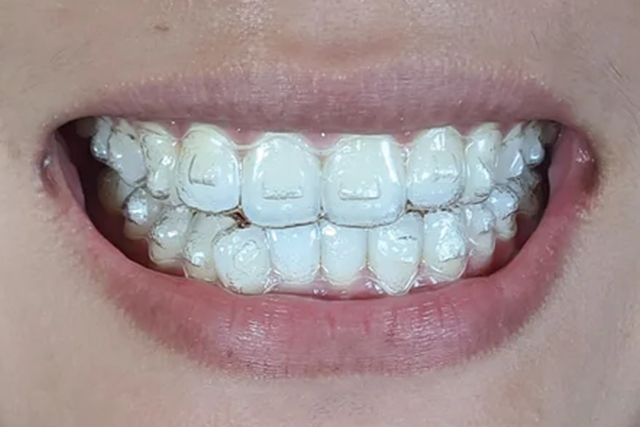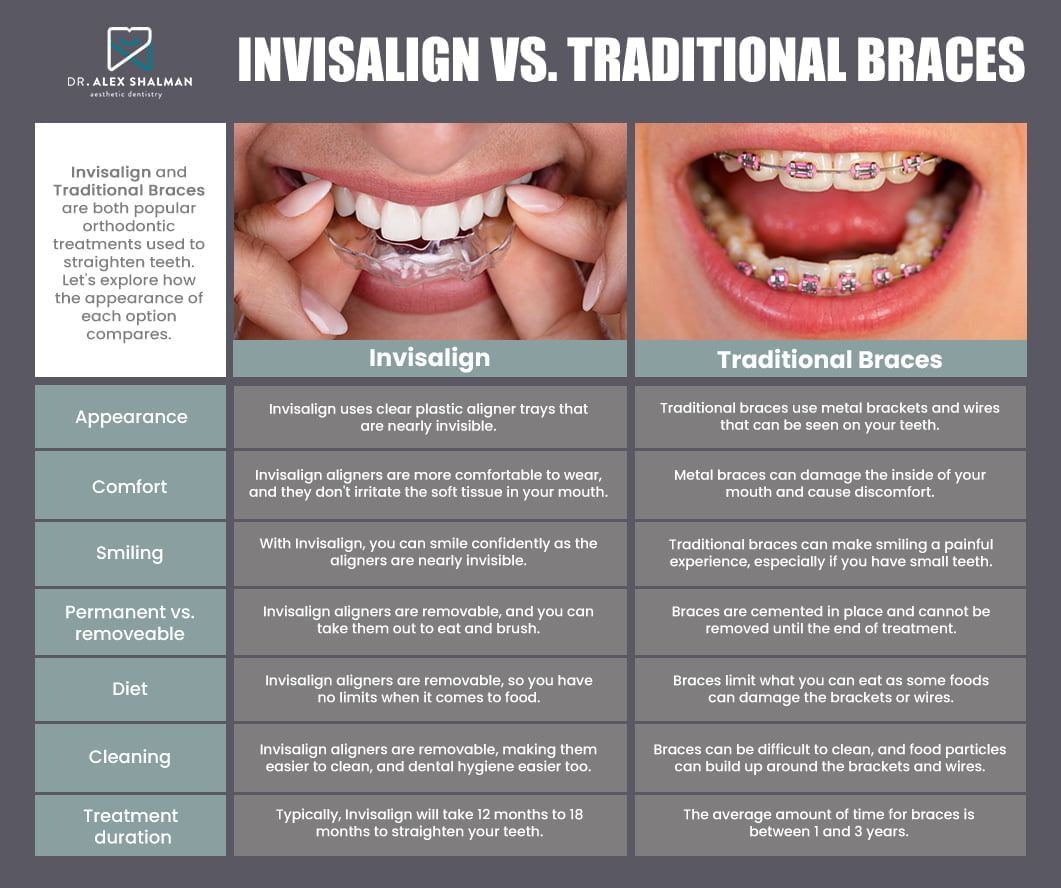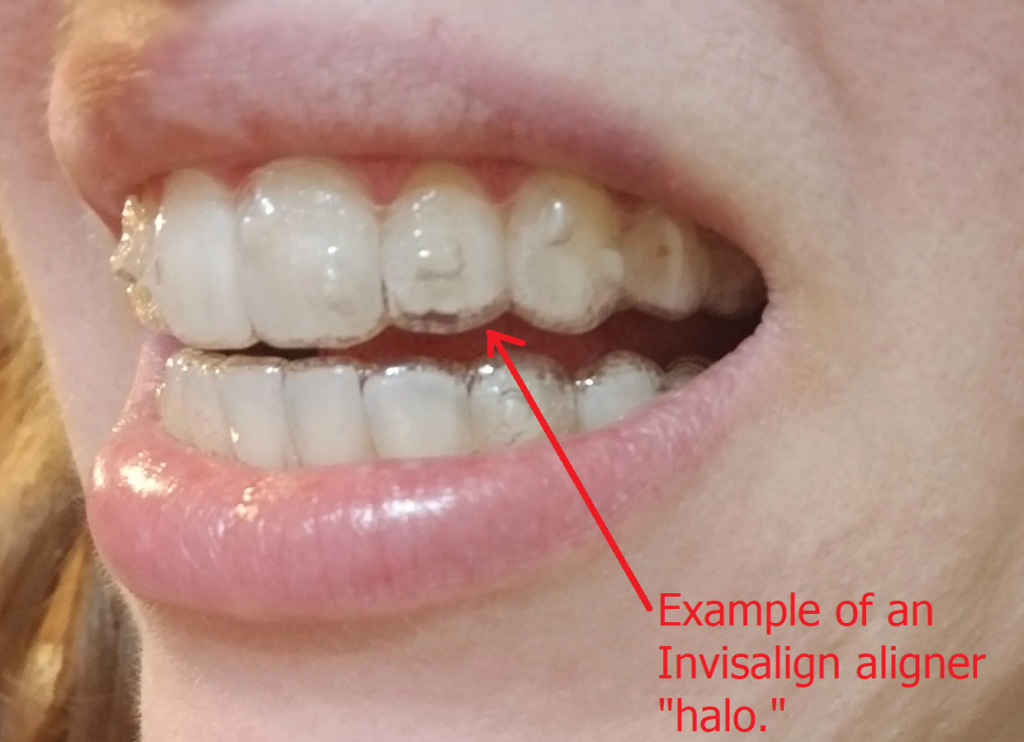Success Stories: How Invisalign Changed Lives and Increased Confidence
Success Stories: How Invisalign Changed Lives and Increased Confidence
Blog Article
Invisalign vs. Conventional Braces: Which Choice Is Right for You?
When taking into consideration orthodontic treatment, the choice in between Invisalign and standard braces provides several important elements that warrant cautious assessment. Invisalign offers a very discreet option with detachable aligners, while standard dental braces give a much more noticeable yet reliable service for extreme imbalance. Each option includes distinctive benefits and disadvantages associated with looks, convenience, therapy duration, and price. Understanding these subtleties is crucial for making an educated decision that aligns with your personal preferences and way of living. The concern remains: which choice will best meet your orthodontic needs and expectations?
Review of Treatment Options

In comparison, typical dental braces consist of metal braces and wires that are bound to the teeth. This method applies continuous pressure over time to achieve placement. While effective for complicated orthodontic concerns, traditional braces need normal gos to for modifications and can position challenges in preserving oral health as a result of the problem of cleansing around cords and braces.
Both alternatives have their qualities, and the choice typically depends upon specific dental conditions, way of living choices, and individual compliance. Ultimately, seeking advice from an orthodontic specialist is essential for establishing the most ideal therapy strategy tailored to individual requirements. Comprehending the nuances of each alternative can substantially influence the total success of orthodontic therapy.
Visual Factors To Consider
A significant factor influencing the selection in between Invisalign and conventional braces is the aesthetic charm each treatment uses. Invisalign aligners are crafted from clear plastic, making them virtually unnoticeable when put on. This very discreet look is specifically appealing to adults and young adults that might really feel awkward regarding their orthodontic treatment. The capability to keep an all-natural smile throughout the placement process can dramatically improve the client's confidence in expert and social settings.
On the other hand, standard braces consist of metal brackets and cords, which can be a lot more recognizable. While advancements in orthodontic technology have resulted in the growth of smaller sized brackets and colored elastics, traditional dental braces still maintain an even more conspicuous profile. For some individuals, the exposure of braces may hinder them from seeking essential therapy.
Inevitably, the choice between Invisalign and traditional braces may depend upon individual choices relating to aesthetic appeals. Individuals who prioritize discretion frequently favor Invisalign, while those that are less worried about visibility may select typical dental braces. Recognizing the aesthetic ramifications of each option is crucial for making an informed decision that aligns with one's way of living and choices.
Convenience and Convenience

In regards to benefit, Invisalign aligners are detachable, enabling patients Our site to appreciate their favorite foods without limitation and keep optimal dental health. Brushing and flossing are simplified, as the aligners can be taken out throughout these regimens, whereas traditional dental braces need careful steering around braces and cables.
In comparison, standard braces necessitate regular changes, making them much less convenient for those with active schedules. Overall, the comfort and benefit of Invisalign make it an enticing choice for several individuals seeking orthodontic treatment.
Therapy Duration and Performance
While both Invisalign and conventional braces work in remedying dental misalignments, the duration of treatment can differ considerably in between both options. Usually, Invisalign therapy can take anywhere from 12 to 18 months, depending upon the complexity of the case. The clear aligners work by progressively moving teeth into their preferred positions, and routine follow-ups with an orthodontist aid make certain development continues to be on course.
In contrast, traditional braces commonly call for a longer dedication, usually varying from 18 months to three years. This is due to their set nature and using brackets and cables, which can be more efficient for complicated situations and extreme misalignments (Invisalign). The therapy efficiency of standard dental braces is well-documented, as they allow for specific changes and higher control over tooth movement
Eventually, the selection in between Invisalign and conventional braces may pivot on both the expected therapy period and the specific dental concerns available. Consulting with an orthodontist is essential, as they can provide tailored recommendations based upon private demands, making certain the selected technique straightens with wanted timeframes and results.
Price Contrast and Insurance Coverage Choices
Expense plays a considerable role in the decision-making process for people thinking about orthodontic therapy, whether selecting Invisalign or conventional dental braces. Typically, the price of Invisalign ranges from $3,000 to $8,000, while standard braces normally set you back in between $2,000 and $6,000. Factors affecting these expenses consist of the intricacy of the instance, the duration of treatment, and geographical location.
Lots of dental insurance coverage plans supply partial insurance coverage for orthodontic treatments, yet the specifics can vary commonly. Usually, typical dental braces may be more frequently covered by insurance coverage plans compared to Invisalign, which some insurance firms categorize as a cosmetic this content treatment.
In addition, several orthodontic methods provide versatile layaway plan, making both treatment options more accessible. Individuals should ask about potential financing alternatives and price cuts for upfront repayments. Evaluating the complete expense, consisting of insurance coverage benefits and repayment plans, is important for making an informed choice that aligns with both visual preferences and budget plan factors to consider.

Final Thought
In summary, the choice in between Invisalign and standard dental braces depends upon several elements, including visual choices, convenience, therapy duration, and expense. Invisalign uses a very discreet, removable option that promotes dental hygiene and nutritional flexibility, while traditional braces may be preferable for complex dental issues and commonly come at a lower cost factor. Inevitably, appointment with an orthodontist is necessary to examine private situations and establish one of the most appropriate treatment option for attaining optimal dental placement.
When taking into consideration orthodontic treatment, the selection between Invisalign and conventional her latest blog braces offers a number of crucial elements that warrant mindful evaluation.Comparing Invisalign and conventional braces discloses distinct therapy choices for orthodontic adjustment.While both Invisalign and standard braces are effective in remedying oral misalignments, the duration of treatment can differ considerably in between the 2 options.Cost plays a significant function in the decision-making process for people thinking about orthodontic treatment, whether choosing for Invisalign or conventional braces.In recap, the selection in between Invisalign and conventional dental braces pivots on several factors, consisting of aesthetic preferences, convenience, therapy period, and price.
Report this page